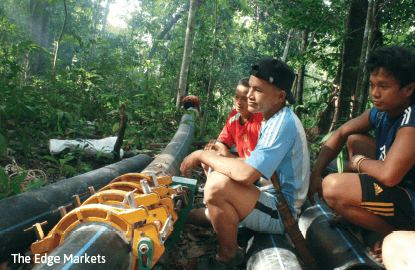
This article first appeared in #edGY, The Edge Malaysia Weekly, on December 21 - 27, 2015.

ELECTRICITY is not something we think much about. You flip a switch and you have light. Simple. But there are places in Malaysia, especially in rural Sabah and Sarawak, that do not enjoy this convenience.
Clean energy social enterprise Penampang Renewable Energy (PRE) is trying to change that. It has been working to install renewable energy systems that can be sustained over a long period and involve the community.
Although government bodies and non-profit organisations (NGOs) have provided similar forms of aid to the indigenous communities, their models are either not up to par or are not sustainable. “A lot of the rural energy systems that I have seen have either fallen apart or are not producing the amount of energy they are supposed to. Also, they usually have inflated budgets,” says PRE founder Gabriel Wynn.
Wynn, an Indonesian based in Sabah, has been working on renewable energy for the last six years. He operated as a non-profit at first but switched to a social enterprise three years ago because Malaysia did not have a big aid mechanism to support rural developments.
“What really makes PRE different is this whole idea of working with the communities, to have the community be in the driver’s seat,” he says.
With only a team of seven, PRE trains local technicians and community members. “Technologies like micro hydro and solar are really just a vehicle. But with these projects, the communities come out with an organised structure and skills that they can use in other development projects as well,” he adds.
Wynn strongly feels that there is no better time to empower these people so that they have the confidence, skills and abilities to develop these projects and their own community.
“I think that if the government were to take this approach to work through this community model and not on the sort of white knight model of just giving people something … the impact could be a lot stronger.
“We’re engaging communities and making them a part of this (the project), they don’t just become a thorn in the government’s side,” says Wynn.
PRE is also trying to demonstrate to organisations and businesses that this is the best way to help the communities if long-term project sustainability is their goal.
The endeavours and pay-offs
Each village has different requirements; a hydropower project can cost from RM15,000 to RM20,000 per installed kilowatt.
To subsidise its bi-community projects, PRE aims to take on at least three commercial projects — such as forest lamps, research stations and eco lodges — each year.
Apart from that, to keep project costs low, PRE also gets buy-ins from community members and have them contribute labour as well as locally-sourced materials.
After the subsidies, the project will cost RM10,000 to RM15,000 per installed kilowatt.
As the communities can’t afford to buy a hydro or solar system right off the bat, the individuals have to pay for the system over four to six years. Hence, PRE facilitates the establishment of local committees that collect payments to ensure that the system is sustainable in the long run.

According to Wynn, civil structures like intake and penstock pipes are damaged during landslides. “That’s why it’s important to have a committee to collect repayments so that there are available funds for repairs or upgrades.”
Each household used to pay a fixed amount each month but PRE soon fixed prepaid meters that come with reload cards, which is a fairer way of distributing electricity.
The mode of payment was changed because some individuals were not getting their full month’s worth of electricity. This was due to degraded watersheds — basically a natural base of rainforest that retains water — that affect optimum power output. “If you have heavy logging activities going on in the watershed, it will compromise the efficiency of the microhydro system or gravity-fed water system,” says Wynn.
Realising that their energy system’s long-term viability is tied to the health of their watershed, communities will go to extra lengths to protect it. Thus, this creates an additional element in protecting the rainforest.
“We have had cases of community members in Sarawak confronting illegal loggers. And they get together to develop watershed protection plans for their hydro systems,” he says.
When these villagers have access to renewable energy, the benefits that follow are numerous. They can refrigerate their food instead of fermenting it for better storage and schools that have received donated computers can now use them.
Save by subscribing to us for your print and/or digital copy.
P/S: The Edge is also available on Apple's AppStore and Androids' Google Play.